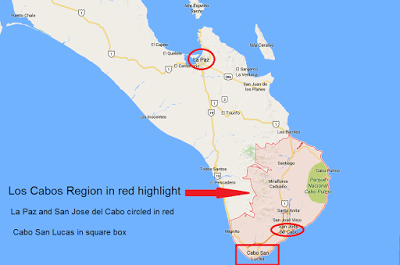

| Online: | |
| Visits: | |
| Stories: |

| Story Views | |
| Now: | |
| Last Hour: | |
| Last 24 Hours: | |
| Total: | |
Los Cabos: 3 dismembered bodies discovered, as narco war continues in region
 |
| Click on image to enlarge |
On Sunday, “hieleras” (ice coolers) were discovered containing dismembered remains. The grisly contents were discarded in the heart of the tourist section of the popular vacation destination of Cabo San Lucas (Baja California Sur). Marking the first such violence in the tourist area.
Although there is a notable increase in violence and homicides in the area, the crime rate in Cabo tourist areas remains extremely low, even by U.S. standards.
The U.S. Department of State warns U.S. citizens about the risk of traveling to certain parts of Mexico due to the activities of criminal organizations in those areas. U.S. citizens have been the victims of violent crimes, including homicide, kidnapping, carjacking, and robbery in various Mexican states. This Travel Warning replaces the Travel Warning for Mexico, issued April 15, 2016. Gun battles between rival criminal organizations or with Mexican authorities have taken place on streets and in public places during broad daylight. The Mexican government dedicates substantial resources to protect visitors to major tourist destinations and has engaged in an extensive effort to counter criminal organizations that engage in narcotics trafficking and other unlawful activities throughout Mexico. There is no evidence that criminal organizations have targeted U.S. citizens based on their nationality. Resort areas and tourist destinations in Mexico generally do not see the level of drug-related violence and crime that are reported in the border region or in areas along major trafficking routes. U.S. government personnel are prohibited from patronizing casinos, sportsbooks, or other gambling establishments in the states of Coahuila, Durango, Zacatecas, Aguascalientes, San Luis Potosi, Nuevo Leon, Tamaulipas, Jalisco, Colima, and Nayarit. Kidnappings in Mexico take the following forms: Traditional: the victim is physically abducted and held captive until a ransom is paid for release.Express: the victim is abducted for a short time and commonly forced to withdraw money, usually from an ATM, then released.Virtual: an extortion-by-deception scheme where a victim is contacted by phone and coerced by threats of violence to provide phone numbers of family and friends, and then isolated until the ransom is paid. Recently, hotel guests have been targets of such “virtual” kidnapping schemes.U.S. citizens have been murdered in carjacking and highway robberies, most frequently at night and on isolated roads. Carjackers use a variety of techniques, including roadblocks, bumping/moving vehicles to force them to stop, and running vehicles off the road at high speeds. There are indications that criminals target newer and larger vehicles, but drivers of old sedans and buses coming from the United States are also targeted. U.S. government personnel are prohibited from intercity travel after dark in many areas of Mexico. U.S. citizens should use toll roads (cuotas) whenever possible. In remote areas, cell phone coverage is limited or non-existent.The Mexican government has deployed federal police and military personnel throughout the country as part of its efforts to combat organized criminal groups. U.S. citizens traveling on Mexican roads and highways by car or bus may encounter government checkpoints, staffed by military or law enforcement personnel. In some places, criminal organizations have erected their own unauthorized checkpoints, at times wearing police and military uniforms, and have killed or abducted motorists who have failed to stop at them. You should cooperate at all checkpoints.
Source: http://www.borderlandbeat.com/2017/03/los-cabos-3-dismembered-bodies.html


